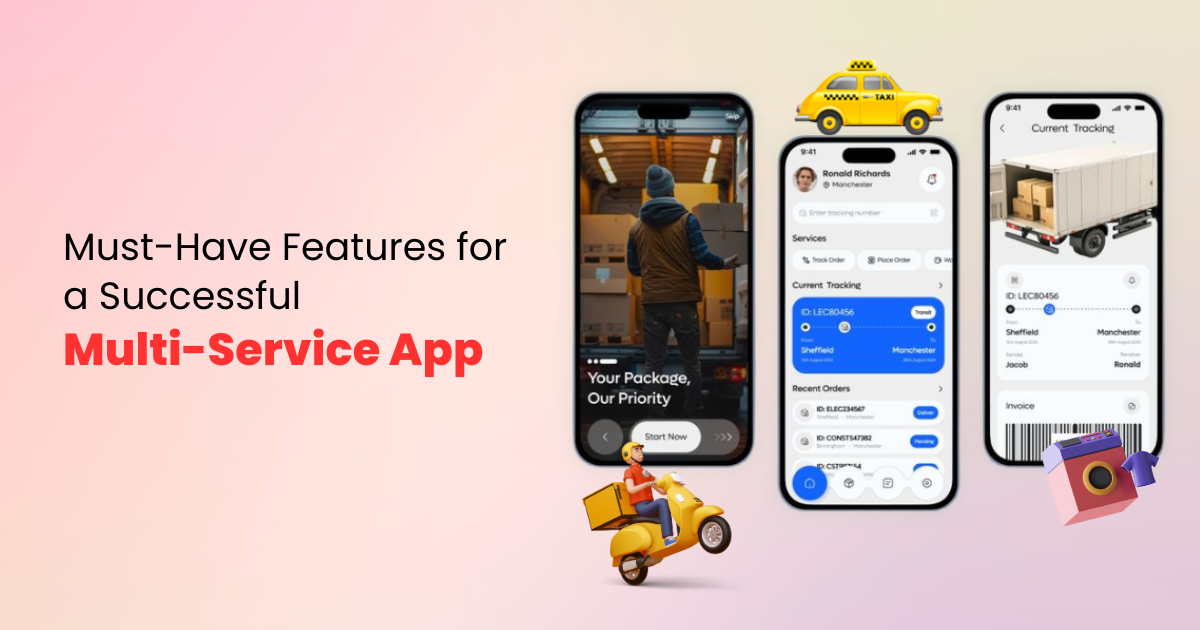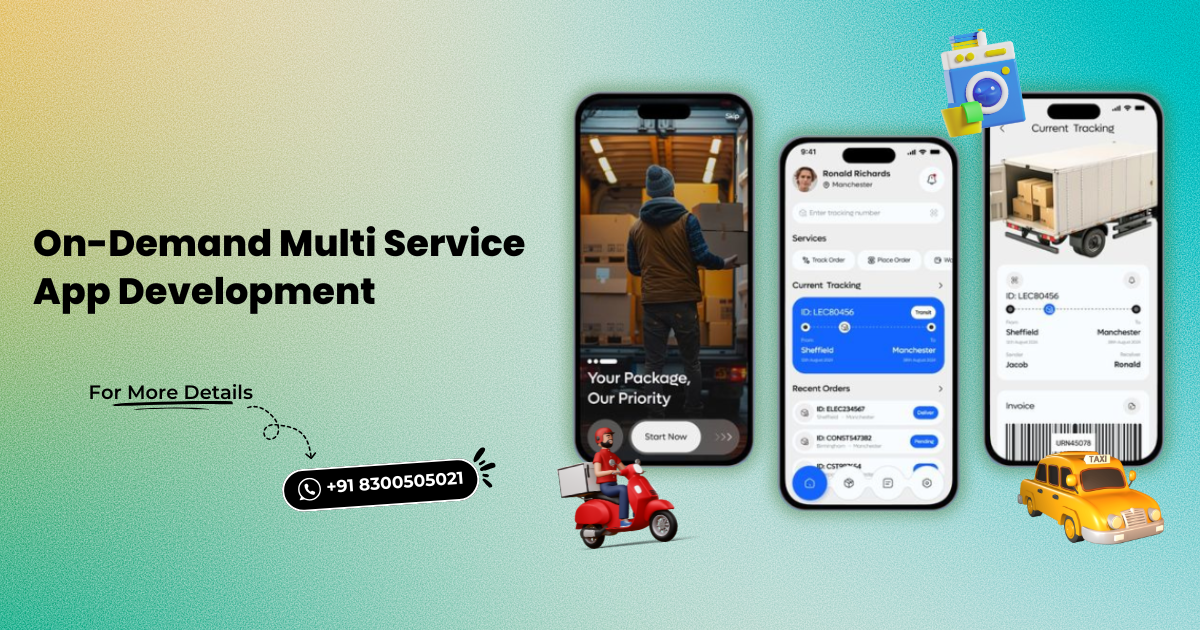The modern digital environment is highly connected, and consumers want all the convenience, speed, and variety of services to be available at their fingertips. This has brought about another trend known as on-demand multi service app development. It integrates all kinds of services, delivering a ride-hailing service, food delivery, courier, and home services, among others, within a multi services super app.
As an entrepreneur or a new company trying to explore this profitable market, starting your own multi-service platform can be a hit. After Gojek, Bolt, and Grab have proved themselves as successful models, there has never been a better time to enter the business of on-demand services.
Throughout this guide, we are going to show you all there is to learn about starting a successful business through on demand multi service app development, including market analysis and core functions, as well as clone scripts and monetization approaches.
Table of Contents
- What Is an On-Demand Multi Service App?
- Why Launch a Multi-Service Platform in 2025?
- Market Potential of Super Apps
- Steps to Launch a Startup with On-Demand Multi Service App Development
- Must-Have Features for a Successful Multi-Service App
- Best Solutions to Build Your Multi-Service App (Gojek Clone, Bolt Clone)
- Benefits of Using a Multi-Service App Script
- Monetization Strategies for Your On-Demand Super App
- Final Thoughts
1. What Is an On-Demand Multi Service App?
An On Demand Multi Sevice App is a digital platform that enables the user to connect with different services ride-hailing, food delivery, grocery shopping, home services, and courier delivery, etc. via one interface.
Rather than downloading individual apps to use on various services, customers can synchronize on one app ecosystem to accomplish a variety of options. This saves on storage space, time, and a seamless customer experience.
2. Why Launch a Multi-Service Platform in 2025?
The demand for on-demand services is constantly increasing worldwide. A multi-service app has multiple benefits when launching, which could be due to the changing consumer behavior and the switch toward mobile-first solutions:
• Great market demand for convenience and instant services
• It is a low-cost solution for both users and providers.
• Increased customer retention based on the bulk services
• A single app with numerous monetizing activities
• Repeatable success experiences such as Gojek and Bolt.
Statista estimates that the on-demand economy will exceed US$335 billion by 2025 worldwide, and this implies massive business opportunities for businesses that can invest in the development of on-demand apps.
3. Market Potential of Super Apps
The origin of super apps is associated with Southeast Asia (Gojek, Grab), but the expansion of the model is occurring worldwide. The emergence of 5G, digital wallets, and mobile penetration has increased the demand for all-in-one app solutions.
- Super apps are fast-growing markets in India and Africa
- Vertical super apps are emerging in Europe and the US
- In tier 2 and 3 cities, localized multi-service platforms are becoming popular
Startups can take advantage of the local demand by creating a specific multi services app development strategy that will allow them to gain a loyal customer pool fast.
4. Steps to Launch a Startup with On-Demand Multi Service App Development
Here’s a step-by-step approach to launching your startup successfully:
Step 1: Define Your Niche and Target Market
Research and find which services you want to add. Common categories such as:
- Ride-hailing
- Food & grocery delivery
- Home cleaning & handyman
- Courier services
- Medical consultations
- Beauty and salon services
Step 2: Do Market Research
Learn how users behave, what competitors offer, local laws, and pricing frameworks. This will assist you in knowing which services are most in demand within your region.
Step 3: Pick the Right Technology Stack
Choose a scalable and safe tech stack that can be used to create on-demand applications, which is mobile app optimized on iOS/Android, a backend server, a payment gateway, real-time GPS, and so on.
Step 4: Select a Trustworthy Development Partner
Find a competent app development business that has expertise in multi-service app development, or select a white-label clone scripts to develop more quickly.
Step 5: Relaunch a MVP (Minimum Viable Product)
Begin by providing the most fundamental services and then build on them over time, depending on user feedback. An MVP strategy will help to reduce the risk and to perfect the platform before launching it on a large scale.
Step 6: Come up with Marketing & Monetization Strategies
Earn the trust of the users through local offers, discounted services, and referrals. Find several monetization options such as commission fee, paid membership, and advertisement.

5. Must-Have Features for a Successful Multi-Service App
Your on-demand multi service app should offer a seamless and intuitive user experience. Here are the essential features:
For Users:
- Easy sign-up & login (social/email)
- Multiple services in one dashboard
- Real-time tracking of bookings and deliveries
- In-app chat and push notifications
- Secure payments and order history
- Ratings and reviews for service providers
For Service Providers:
- Dedicated profile and service management
- Order/booking management dashboard
- GPS tracking and route optimization
- Earnings & performance reports
For Admin:
- Robust admin panel with analytics
- User and provider management
- Commission and payout settings
- Service category control
- Promo codes and discounts management
6. Best Solutions to Build Your Multi-Service App
Building a brand new super app would be expensive and time-consuming. Luckily, there are ready-to-use clone scripts that can be used, such as:
Gojek Clone
A Gojek clone is a white-labeled, full-fledged solution that comes with the main functions and features of the Gojek app. It can support 12+ services on a single platform, which makes it ideal for entrepreneurs who are seeking to start a multi-service app like Gojek.
Bolt Clone
The Bolt clone can perfectly fit to start a multi-service app, including ride-sharing and delivery. It comprises taxi booking services, food delivery, and courier services in a single user-friendly solution.
These clone scripts are also customizable, scalable, and cost-effective to build as compared to scratch, thus they are the first choice of startups.
7. Benefits of Using a Multi-Service App Script
There are a number of advantages to using a multi-service app script such as the Gojek clone or the Bolt clone:
- Faster time-to-market: Put your app into the market in weeks, not months.
- Cost-effective: Save more money during development.
- Customizable: Personalize your brand using services, UI, and features.
- Tested solutions: Tested in advance in terms of performance, bugs, and scalability.
- Scalability: You can easily add new services as your business expands.
Choosing a white-label app solution, you will be able to concentrate on operations and marketing rather than development inconveniences.
8. Monetization Strategies for Your On-Demand Super App
The way to create income with your multi-service platform:
1. Commission-Based Model – Take a given percentage commission on bookings or transactions by service providers.
2. Subscription Plans – Let providers buy monthly subscriptions in order to list services or get premium features.
3. In-App Ads – Advertise through third-party contextual advertising and affiliate brands.
4. Surge Pricing – Introduce dynamic demand-based/location-based/time-based pricing (particularly beneficial in the case of ride-hailing and delivery services).
5. Delivery or convenience Fees – Charge money as a service charge for delivery or dual rates at peak time or quicker service.
An effective monetization strategy is well-planned, enabling the company to turn a profit and offering value to the user and the service provider.
9. Final Thoughts
Launching a startup with on-demand multi service app development is one of the smartest moves in today’s service-centric digital landscape. Whether you choose to develop from scratch or use a Gojek clone or Bolt clone script, the key lies in offering a smooth, scalable, and value-driven user experience.
With the right tech partner, business model, and marketing strategy, you can create a super app that dominates your local market — and possibly beyond.





